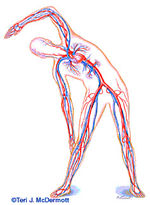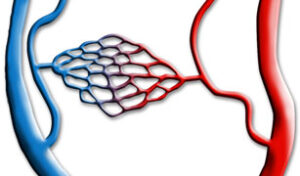|
||
|
|
||
The Blood Vessels |
||
| There are three types of vessels that aid in the transport of blood, and in keeping it in constant circulation from the heart to the body, and back to the heart:
|
||
| Arteries are strong, flexible blood vessels that carry blood from the heart to the rest of the body. They expand to accept the blood pumped into them with each beat of the heart, and contract when the heart relaxes. As the arteries become smaller and narrower they turn into capillaries. | ||
|
||
| Veins are less "active" and elastic than the arteries. They have valves that open to let blood through and close to prevent blood from pooling in the legs and elsewhere due to the pull of gravity. |


 It plays an especially important role in:
It plays an especially important role in: